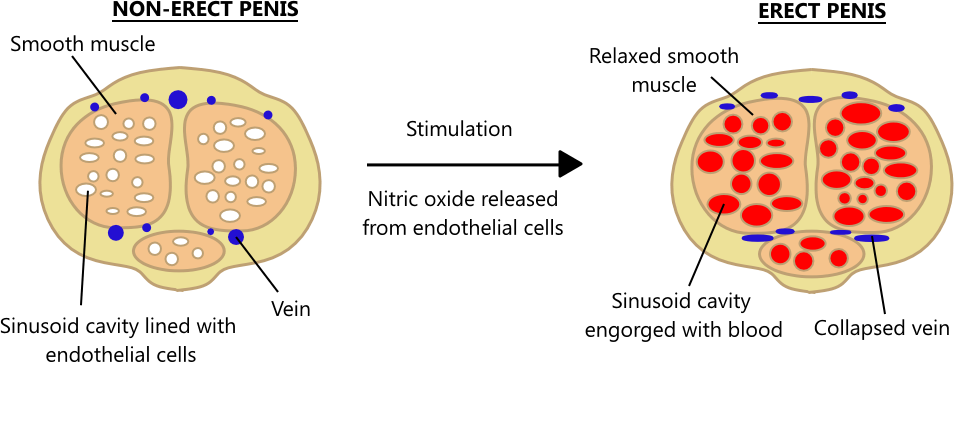Erection physiology and ED
An erection occurs through the following steps:
- The corpora cavernosa of the penis contains a network of smooth muscle cells, endothelial cells, and sinusoid cavities
- An erection begins when endothelial cells are stimulated, causing them to release nitric oxide, which relaxes smooth muscle cells
- Smooth muscle cell relaxation allows the sinusoids to dilate and fill with blood
- Engorged sinusoids compress veins, inhibiting blood flow out of the penis

While the actions above may seem straightforward, the formation of an erection is actually quite complex, relying on the interplay of psychologic, neurologic, endocrinologic, and vascular processes. Issues with one or a combination of these systems can cause ED. Risk factors for ED include the following: (1) Psychological - stress, trauma, guilt, relationship problems (2) Neurologic - neuropathy, prostatectomy, stroke, MS (3) Endocrinologic - low testosterone, diabetes, hypothyroidism (4) Vascular - advancing age, hypertension, obesity, smoking, atherosclerosis.


 While the actions above may seem straightforward, the formation of an erection is actually quite complex, relying on the interplay of psychologic, neurologic, endocrinologic, and vascular processes. Issues with one or a combination of these systems can cause ED. Risk factors for ED include the following: (1) Psychological - stress, trauma, guilt, relationship problems (2) Neurologic - neuropathy, prostatectomy, stroke, MS (3) Endocrinologic - low testosterone, diabetes, hypothyroidism (4) Vascular - advancing age, hypertension, obesity, smoking, atherosclerosis.
While the actions above may seem straightforward, the formation of an erection is actually quite complex, relying on the interplay of psychologic, neurologic, endocrinologic, and vascular processes. Issues with one or a combination of these systems can cause ED. Risk factors for ED include the following: (1) Psychological - stress, trauma, guilt, relationship problems (2) Neurologic - neuropathy, prostatectomy, stroke, MS (3) Endocrinologic - low testosterone, diabetes, hypothyroidism (4) Vascular - advancing age, hypertension, obesity, smoking, atherosclerosis.
